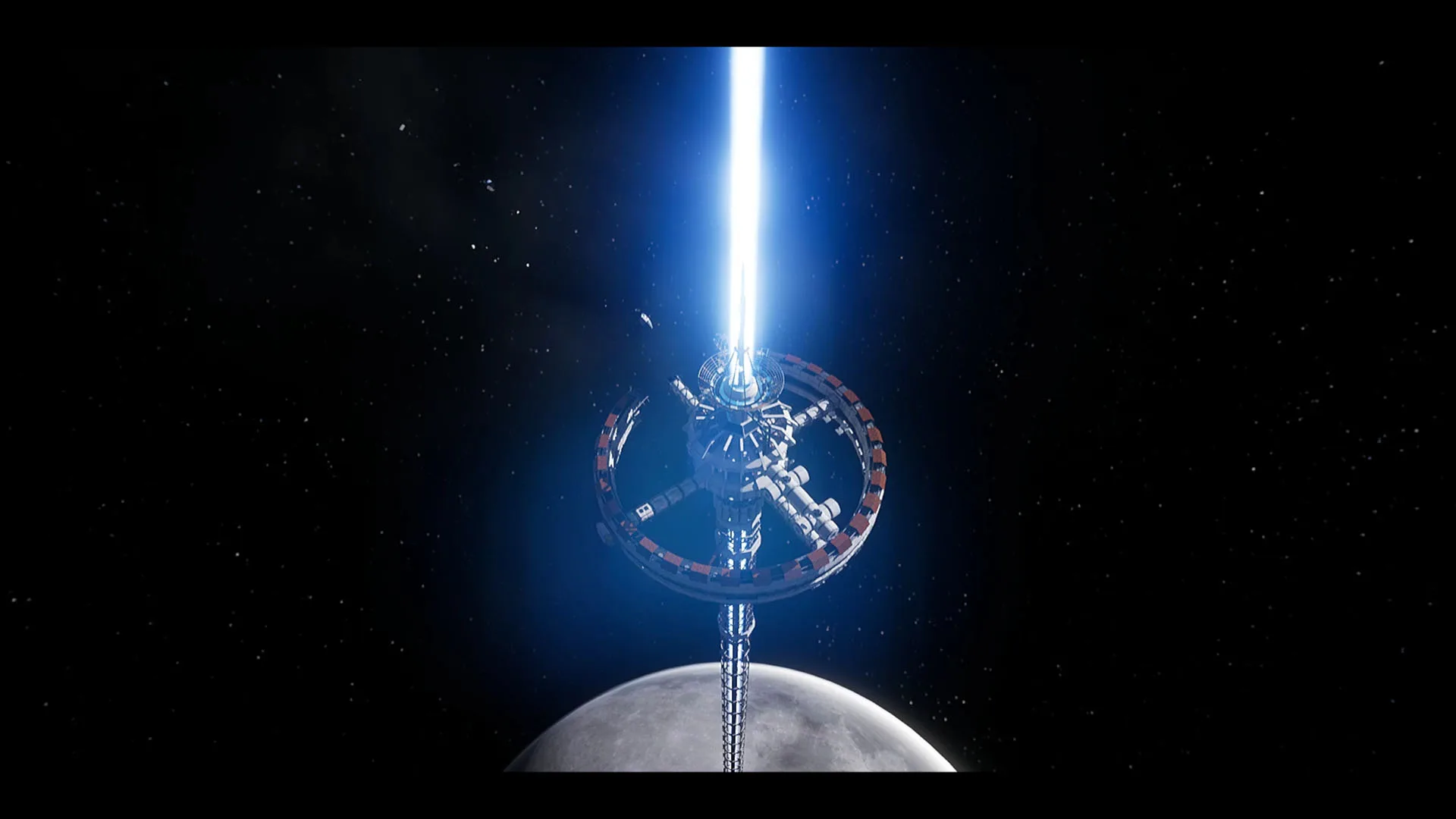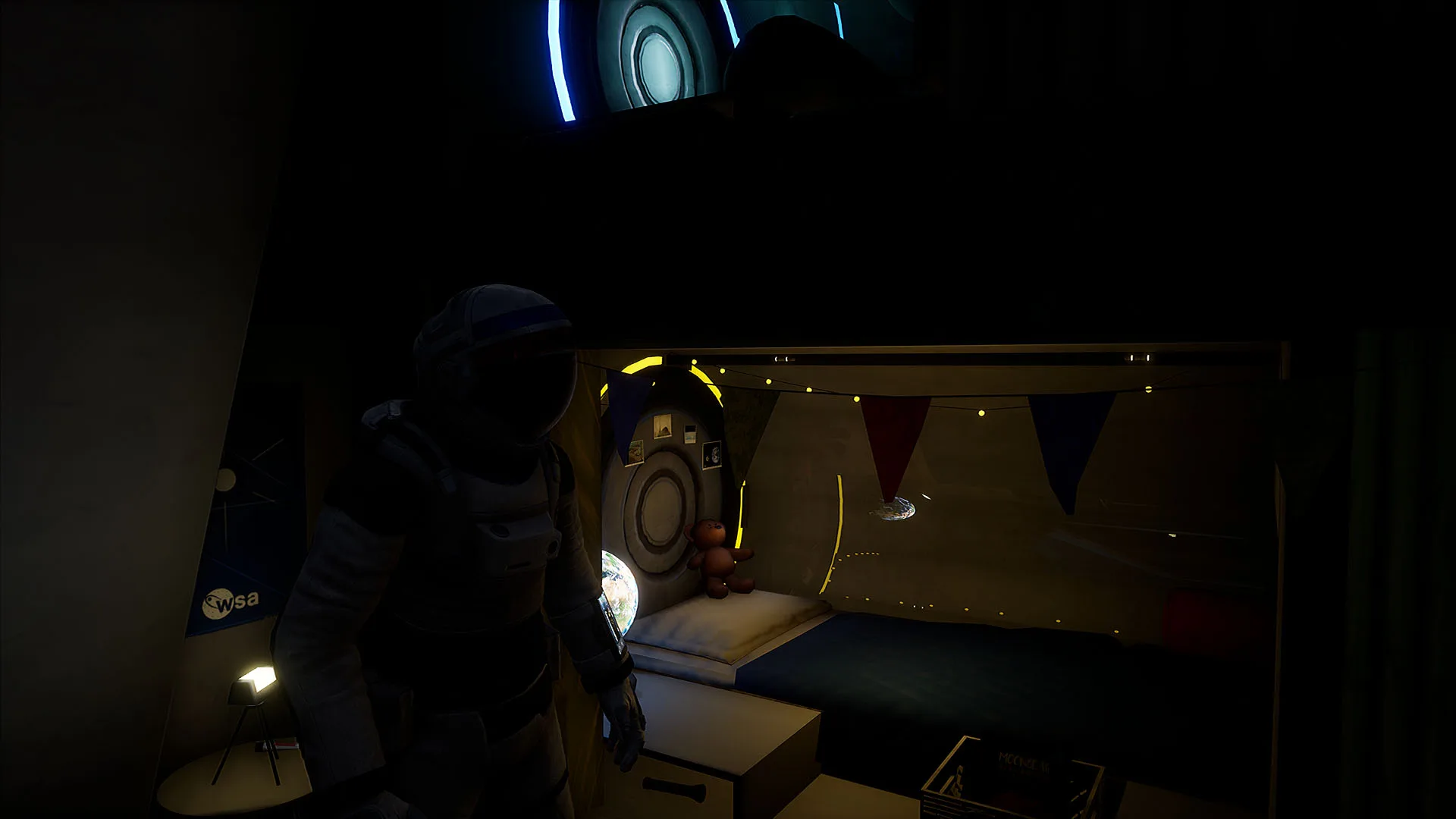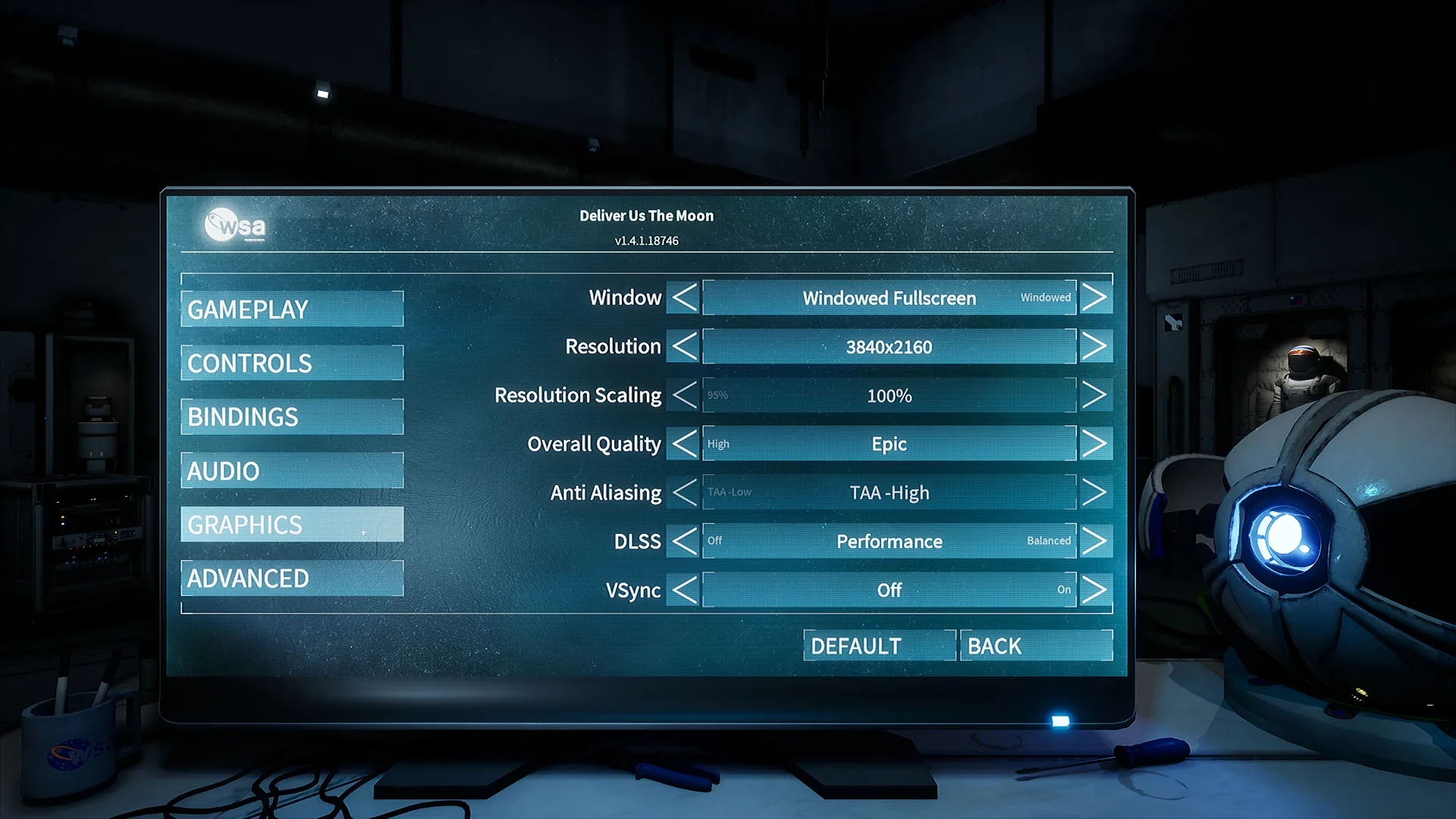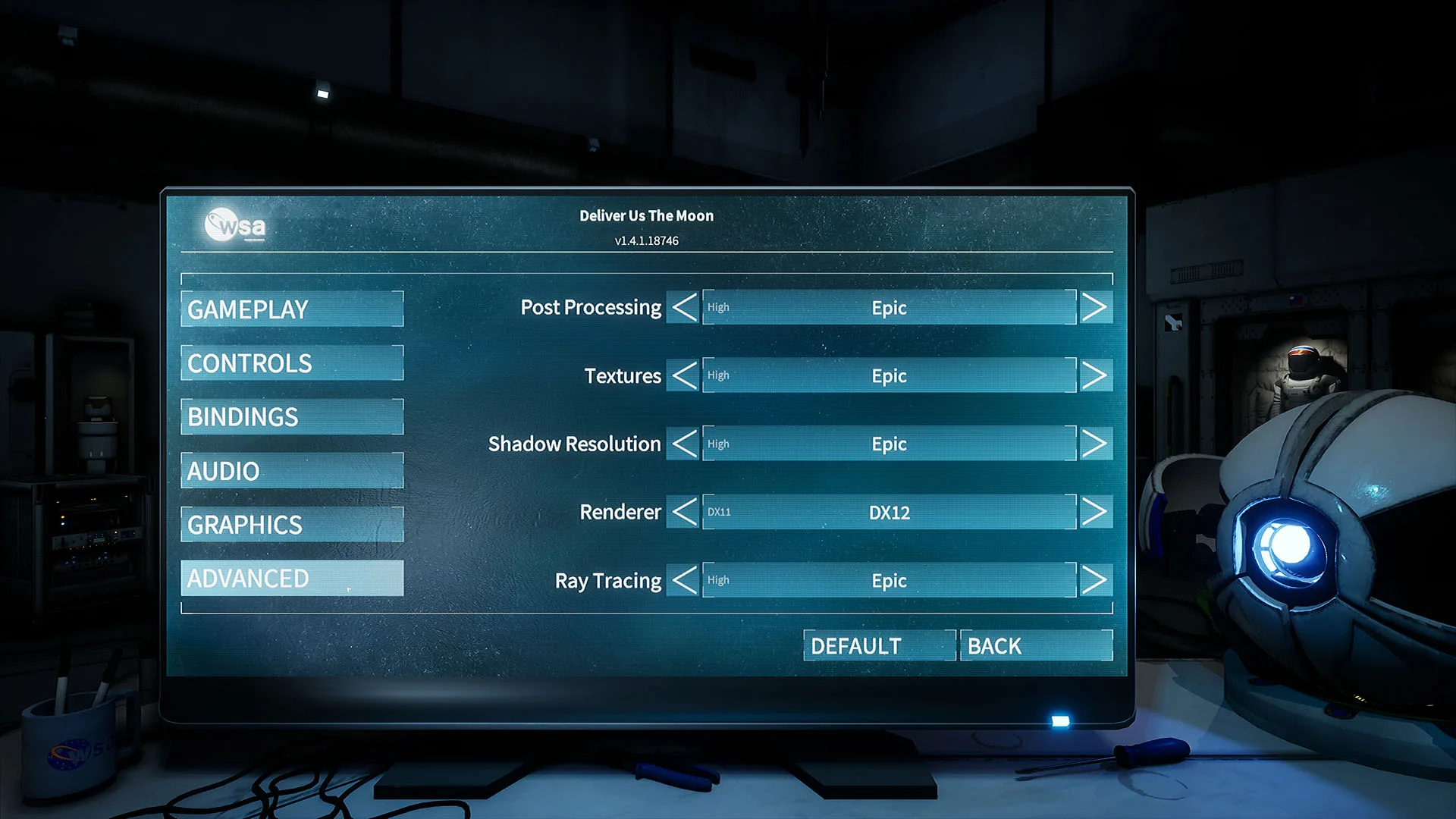Indie Ray Traced Games, Part 1 – the ‘Deliver Us the Moon’ PC Game Performance and Image Quality Review
Eighteen months ago, NVIDIA promised us the moon with ray tracing, and currently there are six AAA games that support it. However, BTR’s indie ray tracing series will cover the image quality (IQ) and performance using all five current RTX cards with the three small studio games that have implemented it so far, beginning with Deliver Us the Moon.
BabelTechReviews received a reviewer’s copy of Deliver Us the Moon for PC courtesy of NVIDIA back in December but we began playing it this last weekend using a RTX 2080 Ti. Once we started playing, we were hooked and we played all the way through the game and its now integrated Tombaugh DLC in two settings.
Deliver Us the Moon was originally announced as a five-part series on Kickstarter in early 2016 and was released unfinished in 2018 as a single standalone title, Deliver Us the Moon: Fortuna. Finally released as a complete game on October 10, 2019, it is published by Wired Productions and available on Steam for $24.99. Here are our impressions of Deliver Us the Moon including testing the performance of its real time ray tracing implementation of reflections and shadows using all the current RTX cards.
Deliver Us the Moon is such a incredibly well-polished and solidly executed game that it is easy to forget that it is an indie effort by a very small group, KeokeN Studios. It’s a short first- and third-person perspective game of perhaps 5-10 hours depending on if a player wants to race through the game or if the goal is to explore its mystery enhanced by a great backstory fed piecemeal to the player by uncovering visual and audio logs and clues. Either way, it will keep a player entertained with action and excitement alternating with good puzzles, a great near-future science fiction backstory, challenging tasks, very natural driving sequences, realistic play in very different environments including in zero-G, synthesized music to fit the mood, and a dark lunar atmosphere that enhances all of its combined elements perfectly.
Deliver Us the Moon throws everything at the player including multiple hectic life-or-death timed races to safety, QTEs, and even some platforming and stealth thrown in – yet it just all fits in perfectly and ties in with the story and its goals. This is perhaps a benefit to having one independent vision instead of a committee to direct an AAA game’s flow.
Deliver Us the Moon immediately starts with rocket launching action right after introducing a plausible near-future Sci-Fi scenario of an earth ravaged by climate change that has completely exhausted its natural resources. The remaining resources were diverted to building a fusion reactor on the moon to use the newly discovered Helium-3. A large permanent moon base was established and the now unlimited energy generated on the moon was beamed back to earth using a massive microwave tower. All was well until suddenly power and all communication were cut off four years ago leaving earth with insufficient resources to launch an organized rescue. The last remaining hope is you as a solitary astronaut who will launch in the last working space craft capable of reaching the moon – and you have to leave now.
Deliver Us the Moon is capable of introducing thrills, heart pounding excitement, and a continuing sense of sustained urgency rarely found in games. Right from the beginning, with a massively destructive storm bearing down, a countdown timer requires the astronaut player to run for the capsule and puzzle out the sequence required to launch before the storm tears the capsule, yours and humanity’s hopes apart. Failing to launch in time requires restarting from the beginning of the checkpoint.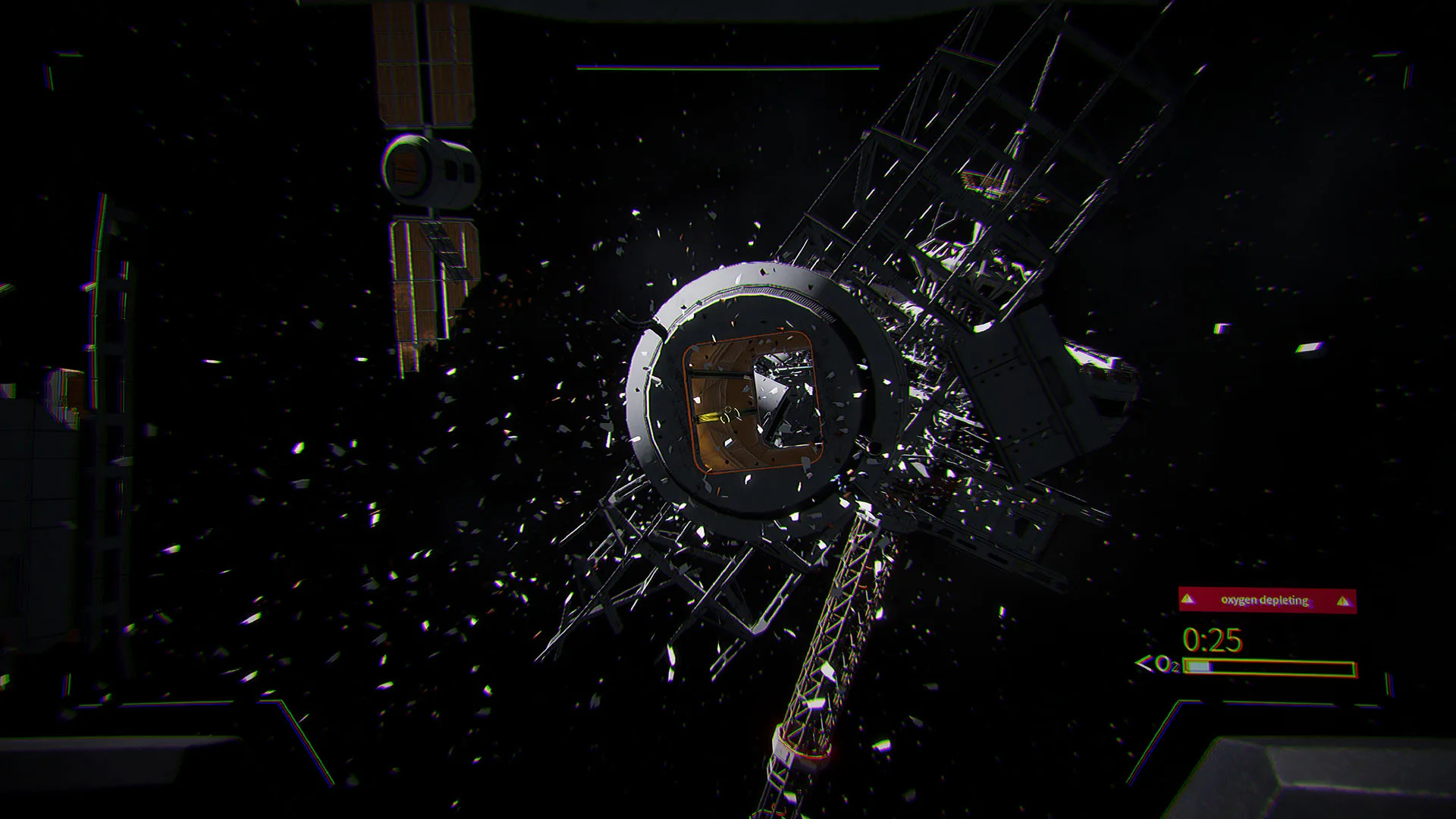
Once you dock with the space station by following a mini-game sequence, you are tasked with restoring power to the elevator that takes you down to the moon base. With almost no external oxygen in your tanks, an explosion blows you into space and you must control your direction toward the elevator’s airlock in the distance while attempting to catch small canisters which each hold a few seconds of precious air. Miss one and you will start over from the checkpoint. The game unleashes a thrilling cinematic style series of events not unlike what occurs in the movie “Gravity” and it is able to repeat this formula many times without wearing it out.
The voice acting, audio, and especially the music are generally excellent, and the music tempo rises as the action heats up adding to the player’s excitement. The music also impacts each scene adding to the emotion of loneliness or contributing to the feelings of despair or hope. Some of the voice actors are perfect for their major roles while some of the minor parts are rather amateurish, but overall the audio would fit well into a AAA studio effort, rising well above what an indie studio is usually capable of.
Deliver Us the Moon is not a particularly short single player experience as the moon base the player is powering back on is a formerly extensive operation to mine Helium-3 and transmit energy back to earth. We completed the six missions in about 10 hours but we stopped to read and view everything we came across. We suspect that a player used to puzzle solving who does not explore beyond what is necessary to complete the game may be able to finish it in four to six hours.
By exploring and listening to every audio and holographic log, email, and note, a compelling narrative unfolds explaining what happened to the people who lived on the moon and what caused the energy blackout. Couple this with the need to power up the base and deal with an unstable reactor makes for a great story with a lot of action and urgency, but it also shows the way families lived and worked on the moon and how they dealt with the totality of the critical events that lead to their disappearance and the catastrophic power failure affecting earth. There are some minor weaknesses with the writing, but overall, Deliver Us the Moon is well done and it balances the intensity of the action parts of the game with its story and exploration.
The player is alone with no other human to communicate with other than hearing occasional snippets of transmissions that make suggestions and guess at progress by what can be observed back on earth. Stopping to pick up notes and listening to recordings and watching videos greatly adds to the atmosphere, and they often give the player hints on how to proceed through the puzzles. In the tradition of a good novel, a player begins to understand the mechanics and the mind of the developers, and one may see patterns which may help to solve Deliver Us the Moon’s many puzzles.
Some of the Deliver Us the Moon puzzles take a lot of thought and some are very complex but solving them are necessary to proceed. You are going to move a lot of batteries around the under-powered moon base to shut down areas you visited and to open areas formerly closed off. One of the puzzles involves aligning four 3-way lights controlled by four switches each of which control multiple lights.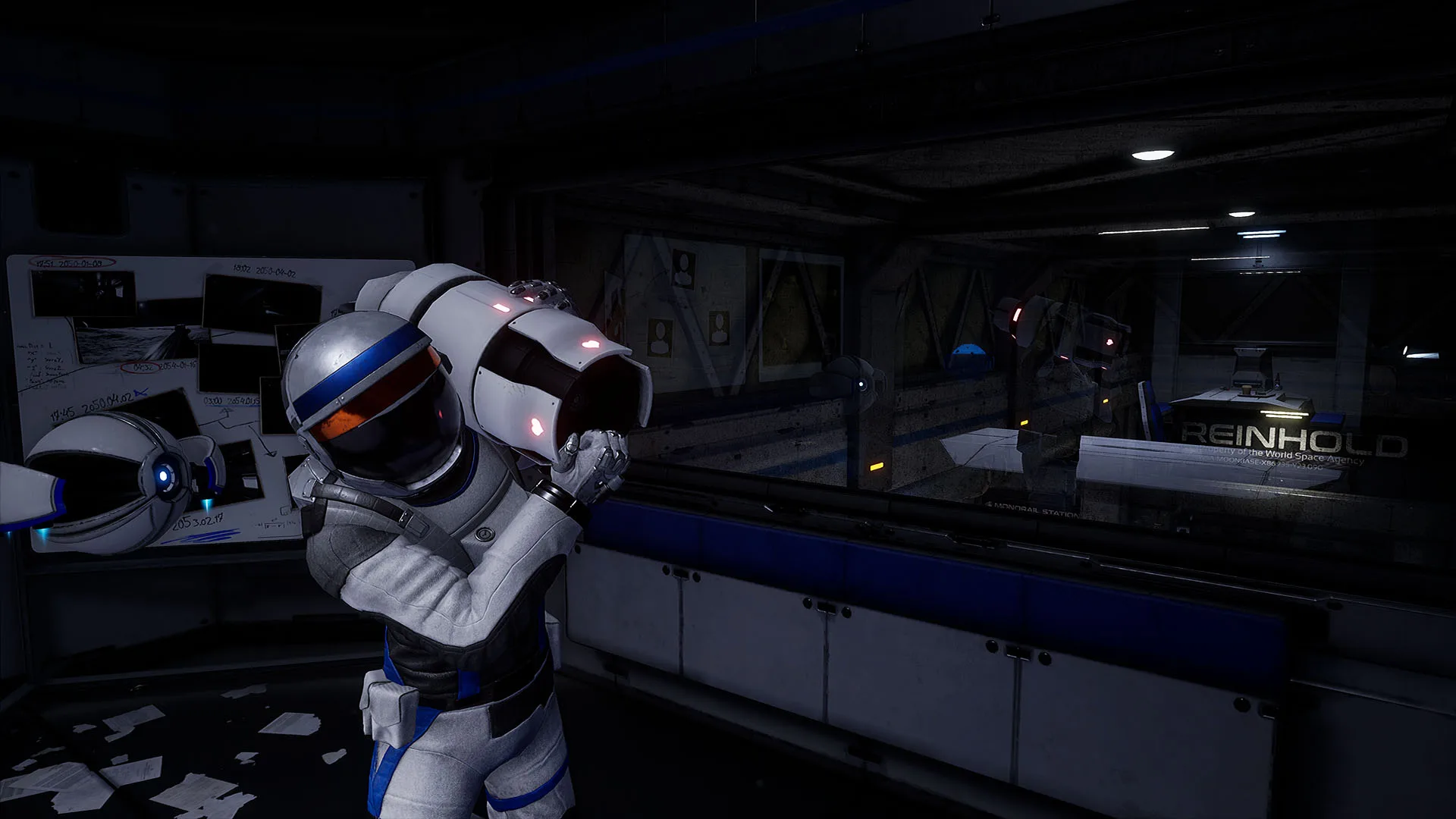
Another complex puzzle involves rebuilding your only companion, an AI ASE hovering drone about the size of a basketball that can assist the player by reaching otherwise inaccessible areas through vents and opening locked areas as well as by playing holograms which advance the story. Besides the ASE AI drone, the player has a plasma energy cutting tool to allow him to open certain areas. It cannot be used as a weapon although the player has to occasionally hide from killer robots. For a game with no fighting, Deliver Us the Moon is both exciting and engrossing.
We neglected our chores, missed meals, went to bed late and then woke up early to get right back into it – a rare indie game indeed! Although this reviewer hates the checkpoint system, Deliver Us the Moon’s is well implemented. When your avatar dies, you don’t have to start over way back nor are you forced to watch any cutscenes. Loading is very fast from a SSD and you get right back into the action.
Deliver Us the Moon appears to have little replayability. Mostly a player will want to explore everything on the first playthrough although the chapters unlock after the game ends if a player wants to get a missed achievement. There appear to be no major game-breaking bugs, but during more than 10 hours of play, we experienced a single situation where moving an object into the elevator got stuck and required us to restart from the checkpoint.
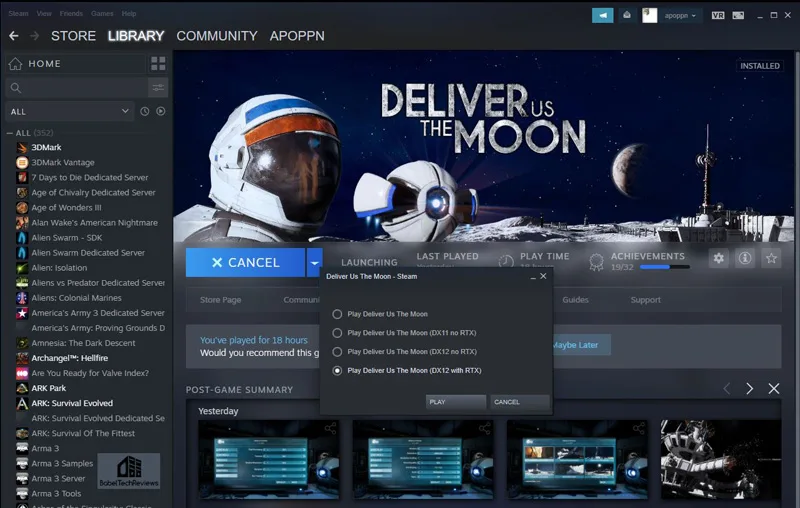
Deliver Us the Moon offers multiple choices on launch of DX11 or 12, and RTX on or RTX off. We also experienced some issues with setting non-native resolutions as the game only offers Windowed and Windowed Fullscreen, and sometimes the resolution refused to stick or would even revert making benchmarking a challenge.
One thing that immediately stands out is the detail and impressive graphics on Deliver Us the Moon’s higher setting. The character is reasonably detailed and the world is immersive. The settings are diverse for being set in space – earth, the inside of the spaceship, the space station, multiple space walks, a vast moon base, and areas on the moon’s surface that may be explored by a lunar vehicle or a monorail. Occasionally there are some weak textures that stand out, but generally the graphics are excellent.
Performance Options
Here are the Epic graphics settings that we generally used. Please note in the screenshot above, that Performance is the default DLSS option for 4K and Quality is used for 1920×1080 and for 2560×1440 resolutions. We picked Epic and the highest settings for benching.
Ray Traced Reflections
Instead of prebaked rasterized lighting that game developers have had to use, ray traced reflections gives superior lighting which work well with the lunar and space effects that Deliver Us the Moon strives for. NVIDIA worked with the Deliver Us the Moon devs to create realistic lighting effects that cannot be achieved with rasterized lighting and they added DLSS for anti-aliasing using upscaling to maintain high performance. 
Deliver Us the Moon’s moon base environments are a good showcase for global illumination and reflections which cast realistic reflections on reflective surfaces, increasing image quality and enhancing immersion. Note the extra detail comparing a scene with ray tracing on vs off. Using ray tracing, the ray-traced reflections are based on the exact geometric detail and dynamic lighting of a scene to casts realistic reflections on reflective surfaces for better image quality.
[twenty20 img1=”16387″ img2=”16386″ offset=”0.5″]
Deliver Us The Moon uses ray-traced shadowing to enhance the accuracy of shadow maps cast from various light sources. By combining shadow maps with ray tracing, the scenes with heavy shadows can be rendered at a higher level of detail. However, this additional ray tracing takes a significant performance hit.
Performance
 With Epic settings including ray tracing plus the highest level of TAA at 4K resolution, NVIDIA’s fastest consumer video card, the RTX 2080 Ti struggles below 30 FPS. Deliver Us The Moon only runs smoothly above 60 FPS at 1920×1080. To play at highest settings and with ray tracing on highest settings requires the use of AI super resolution or DLSS (Deep Learning SuperSampling) which provides IQ similar to TAA but with better framerates. Ray tracing provides the next generation of visuals, and coupled with DLSS it boosts performance to be able to play at decent frame rates.
With Epic settings including ray tracing plus the highest level of TAA at 4K resolution, NVIDIA’s fastest consumer video card, the RTX 2080 Ti struggles below 30 FPS. Deliver Us The Moon only runs smoothly above 60 FPS at 1920×1080. To play at highest settings and with ray tracing on highest settings requires the use of AI super resolution or DLSS (Deep Learning SuperSampling) which provides IQ similar to TAA but with better framerates. Ray tracing provides the next generation of visuals, and coupled with DLSS it boosts performance to be able to play at decent frame rates.
Deliver Us The Moon brings new DLSS modes: Quality, Balanced, and Performance. These three options control the DLSS rendering resolution, allowing a gamer to choose a balance of IQ and framerates. For 1920×1080 and 2560×1440 resolutions, the default is set to Quality but 3840×2160 is set to Performance.
This next chart compares Deliver Us The Moon performance using the five current RTX cards at 3840×2160, 2560×1440, and 1920×1080 resolutions at the highest Epic settings. The first comparison uses TAA but no ray tracing nor DLSS. The second set of performance numbers show the same Epic settings but now with ray tracing on Epic and with Quality DLSS instead of TAA. Finally, the third comparison uses only the RTX 2080 Ti on Epic but using the Performance DLSS setting instead of Quality.
Deliver Us The Moon is not a fast-paced shooter and framerates down into the mid-40 FPS range are generally acceptable especially if a gamer uses G-SYNC. However, using a higher standard of 60 FPS as average, the RTX 2080 Ti is more than an acceptable 4K card on Epic settings/High TAA without ray tracing. Using Quality DLSS and Epic ray tracing drops framerates to just acceptable in the upper 40s, but Performance DLSS instead of Quality brings it back into the 4K/60 FPS range. In the same way, the RTX 2080 SUPER is good for 4K without ray tracing but it really shines at 1440P with Epic ray tracing and Quality DLSS enabled.
The RTX 2070 SUPER can easily manage 2560×1660 on Epic without ray tracing and it is also certainly possible to play with Epic ray tracing but we would suggest using Performance or Balanced DLSS instead of Quality. Unfortunately, a resolution bug kept us from benching the 2560×1440 resolution with the lower three cards. The RTX 2060 SUPER can easily handle Epic ray tracing with Quality DLSS at 1920×1080 and the RTX 2060 can also manage it, but if the minimums drop too low, Performance or Balanced DLSS is a good option.
DLSS gains back a significant percentage performance of the non-ray traced game over using TAA instead. DLSS adds a slight blur and it isn’t perfect adding some minor banding and artifacting, but overall it looks great with the camera in motion. NVIDIA emphasizes that DLSS is a work in progress that gets better with more training.
Here are some screenshots comparing (1) RTX on versus RTX off, (2) RTX on with Quality DLSS versus High TAA, and (3) RTX on with Quality DLSS versus Performance DLSS.
RTX Off vs. RTX On Epic settings and High TAA
First up, at 4K/Epic settings and with High TAA (no DLSS), we compare Epic ray tracing off versus on.
[twenty20 img1=”16412″ img2=”16413″ offset=”0.5″]
It’s really obvious that ray tracing adds a lot to the visuals of the scene just by turning it on.
RTX On – Quality DLSS vs. High TAA
Now we compare the same 4K/Epic ray tracing with TAA (slider to left) vs. with DLSS (slider to right).
[twenty20 img1=”16414″ img2=”16412″ offset=”0.5″]
There are differences. However, overall with the camera in motion, Quality DLSS looks very similar in overall IQ to High TAA.
RTX On – Quality DLSS vs. Performance DLSS
Next we want to see the image quality differences between Quality (slider to left) and Performance DLSS (slider to right).
[twenty20 img1=”16415″ img2=”16414″ offset=”0.5″]
There is some IQ loss using the Performance DLSS compared with the Quality DLSS that may be roughly comparable to High TAA versus lower levels. With the camera in motion, Performance DLSS is a decent option. Balanced DLSS fits in-between Quality and Performance and it is worth checking out when balancing IQ versus performance.
The best time to check out real time ray traced reflections is while exploring. You will not be able to admire the pretty visuals while racing to grab that next oxygen canister or you will die. We played a portion of the game in DX11 and we still enjoyed it thoroughly – however, we missed the ray traced reflections with them off. There is no other way to put it – ray tracing adds to a game’s visuals; and in the case of Deliver Us the Moon it adds quite a bit.
Conclusion
Deliver Us the Moon is a really good game and it has brought the most fun, challenge, and frustration that we have had in a long time. We were completely taken with and consumed by Deliver Us the Moon only stopping to eat and to sleep – and sometimes forgetting to eat. We neglected everything else while playing it. We went to bed late, exhausted, and when we woke up the next morning early, we returned immediately to playing.
Deliver Us the Moon is a really fun game right from its opening and it pulls you into its world delivering epic moments with such impact and intensity that almost define gaming immersion coupled with a great story to explore and with good puzzles to solve. If you are a completionist, you may put over 10 hours into the game. If you just stick to the main storyline, you may play for 4-6 hours if you are a good puzzle solver.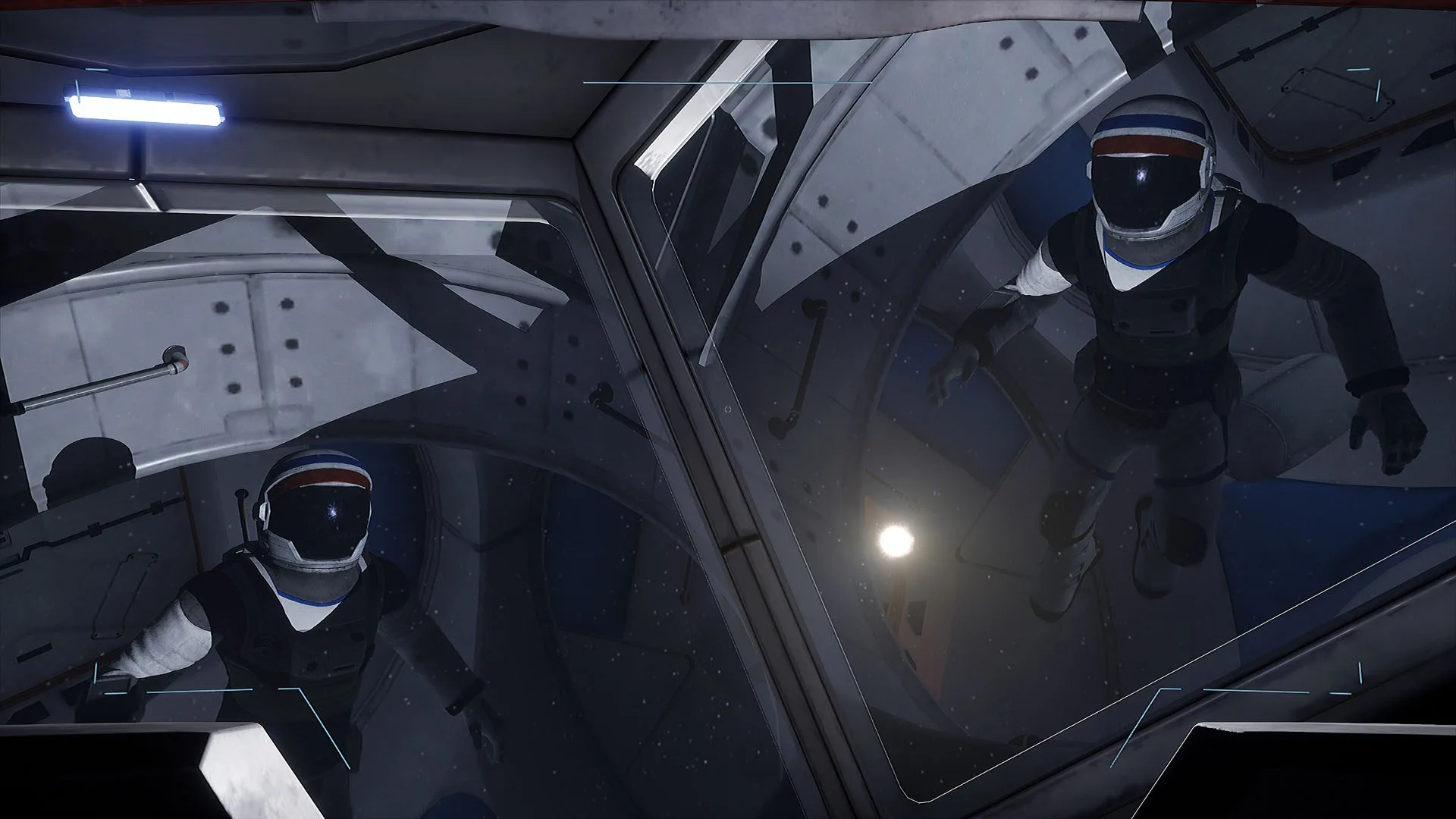
Deliver Us the Moon deserves an “7.9/10” in our opinion as an excellent game that demands thinking, precision, and good puzzle-solving ability. It is hard to believe that an indie studio was able to put out such an awesome effort and we look forward to their other games. The visuals are absolutely outstanding and the ray tracing effects add to the immersion.
Next up, we are going to revisit VRSS, this time with Boneworks.
Happy Gaming!
